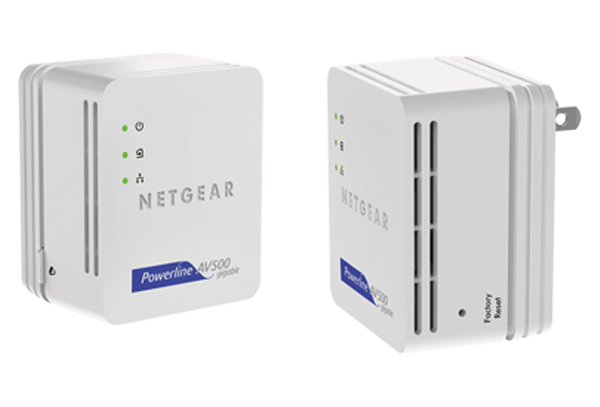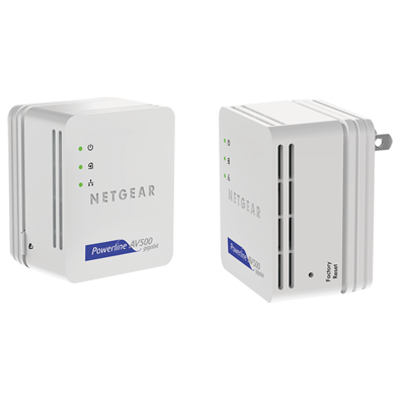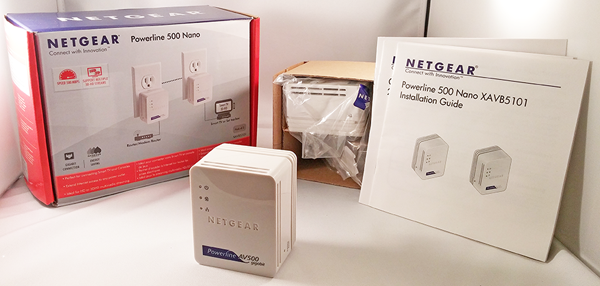Early Verdict
Netgear falls into the same boat as the Linksys PLEK-500, except it was more consistent in being the worst performer. Temper that statement though with the consideration that the lowest throughput was 41 Mbps. Practically speaking though, depending on where you position the Netgear XAVB5101, they could still prove useful. Netflix reports 1080p streaming at about 5-6 Mb/s, with 4K requiring over 15 Mb/s, so even at the lowest throughput Netgear XAVB5101 still provides room for three 4K streams or nine streams at 1080p.
Pros
- +
Plug and play • Nano form-factor • Three-color throughput indicator with speed reference • Advanced configuration utility available • Power save mode
Cons
- -
Consistently slower performance by comparison
Why you can trust Tom's Hardware
Specifications, Features And Accessories
With the powerline adapters we've reviewed up to this point, we have noticed a trend that individual adapters have a slight model number variance compared to the powerline adapter kits, which include a pair of adapters. Netgear continues that trend with its XAVB5101 Powerline adapter kit. On the company's website, the adapters are listed in the home networking department under the powerline link.
Specifications
MORE: Powerline Networking 101MORE: How We Test Powerline AdaptersMORE: All Powerline Content
MORE: All Networking Content
The technical specifications state that the nano-class (more on that later) XAV5101 employs the HomePlug AV standard, rather than HomePlug AV2 like some of the other adapters we've reviewed, but is modeled for use with a GbE adapter for connectivity purposes. The operating range of these adapters is from 2MHz to 80MHz, with data rate claims topping out at 240 Mb/s. When compared to other adapters that we previously tested in our powerline round-up, Netgear's XAV5101 operates with the highest MHz range cap. Power usage while actively transmitting appears to meet the average of its peers, coming in at a reported 4.5W.
On the HomePlug Alliance Certified Products List, Netgear's XAV5101 is easy to find; just apply the HomePlug AV search filter. The product packaging specifies that the kit is HomePlug AV-compliant, and the HomePlug Certification Mark is clearly visible near the package contents list.
While there's a "Push-and-Secure" button on one side to factory-reset the XAV5101, you have to insert a paperclip into the designated hole on the opposite side of each unit.
Features
Netgear's XAV5101 includes an energy savings mode, a Pick-A-Plug feature as well as a number of security options. Through its gigabit Ethernet port, the Netgear XAV5101 enables interoperability with other devices that adhere to the IEEE 802.3 standards.
On the side panel, there's a "Push-and-Secure button" that sets the powerline network password. Communications over the powerline network are then protected via 128-bit AES encryption, which includes key management. Pressing the button on one of the adapters starts a syncing process, during which you have to press the button on the kit's other adapter so it will sync appropriately within five minutes. If you want more granular control over the powerline network membership, you can download Netgear's Powerline Configuration Utility.
Get Tom's Hardware's best news and in-depth reviews, straight to your inbox.
Netgear also includes a power-saving mode that cuts the XAV5101's consumption to less than half of one watt. When the Power LED shines amber, it is in power-saving mode. It takes 10 minutes of idle time before the mode is triggered, so you don't have to worry about flip-flopping between active transmitting and standby.
Pick-A-Plug is touted as a way to plug the adapters into different ports for the purpose of determining the best transmission rate. The Powerline LED indicator shines green for link rates above 80 Mb/s, amber for rates in excess of 50 Mb/s but less than 80 Mb/s, and red if the link rate drops below 50 Mb/s.
According to a 2011 press release, Netgear began manufacturing nano-class adapters after recognizing other powerline adapters at the time were large to the point of blocking two outlets. Nano-class adapters are made to avoid this.
Accessories
Inside the box, you will find two Netgear XAV5101 powerline adapters in a cardboard cutout, two 6.5-foot cables with RJ-45 ends and a quick-start guide. The kit is protected by a one-year hardware warranty.
Current page: Specifications, Features And Accessories
Next Page Hardware, Software And Tear-Down-
Gigahertz20 Powerline networking is too inconsistent, I bought a bunch to network a friends house and they were terrible for speeds so they got returned. We bought a couple MoCA adapters and networked his house using the existing coax cable outlets, works great. I wish MoCA would have caught on more, they are a little expensive but totally work it. Just search for MoCA 2.0 on Amazon, you can get two bonded MoCA 2.0 adapters for around $190. The 2.0 version is suppose to be very fast.Reply -
rantoc Doing only bandwidth measurements don't paint the entire picture, latency is in many cases are even more important than the pure bandwidth (when speaking about faster connections)Reply -
malhussaini re:rmse17Reply
Latency in my experience for powerline networks is 3-4 ms compared to less than 1 ms for ethernet. -
az_fred I bought a pair of Netgear AV500 powerline adapters about a year ago. To my surprise they are working out wonderfully. One unit actually has built in WiFi to cover a dead spot in my house. I can consistently get over 30 Mbps over WiFi which is great for browsing and movies on my tablet. It works nearly all the time, with an occasional reset. The pair only cost about $70 at my local Fry's. It was much better than I thought it was going to be!Reply -
InvalidError Same room, floor or whatever else is of little importance. What matters is wiring distance and tidiness between the two adapters.Reply
If both adapters are on the same breaker run (often but not always the case within a given room) and there are no dirty loads putting noise on it or EMI filters attenuating the signal, you get good performance. If the two adapters are on different breakers on the same phase at the breaker box, you get lower performance due to additional attenuation and wiring in-between. If the other adapter is on the other phase, you get worse attenuation still since only the signal traveling on the neutral reaches the other branches and further reduced performance. -
truerock Is Matthew Matchen mentally unstable. How could he write an entire article about Powerline and not explain how home electrical wiring is done. Somehow he thinks that the distance between 2 electrical outlets is somehow relevant. Is Matchen completely braindead?Reply -
dragget We've now had two successive Powerline reviews. Both kits reviewed have been based on HomePlug equipment that is 3-4 years from the current state of the art. I have a set of HomePlug AV2 adapters that I've been using for 4 years now which are based on the same chipset as the units in the review. Personally, I'd prefer information on how the new MIMO stuff stacks up. Wouldn't it be more helpful to most of your readers to test and review newer products?Reply -
truerock The AV2-MIMO adapters typically run around 100Mbps in a worst case scenario (e.g. long run through a circuit breaker). The newer G.hn adapters (e.g. using Marvel chipsets) increase that to about 140Mbps.Reply
I have no idea why anyone would waste their time testing obsolete Home AV adapters. -
truerock http://www.homeplug.org/explore-homeplug/faq-consumers/#AV2aReply
I’ve read about AV2 for a while, how is AV2 MIMO better than existing HomePlug AV and AV2 products?
The short answer is improved quality of service (QOS) and coverage to all areas of the home. The existing HomePlug AV and AV2 products use 2 wires (hot and neutral) and can be referred to as “SISO” (for single-input / single output). AV2 MIMO with beam forming uses those 2 wires plus the ground to greatly increase the reliability of high-bandwidth service to all areas of the home by a factor 2 to 4 times as compared to earlier technology (MIMO stands for multiple-in / multiple out).


